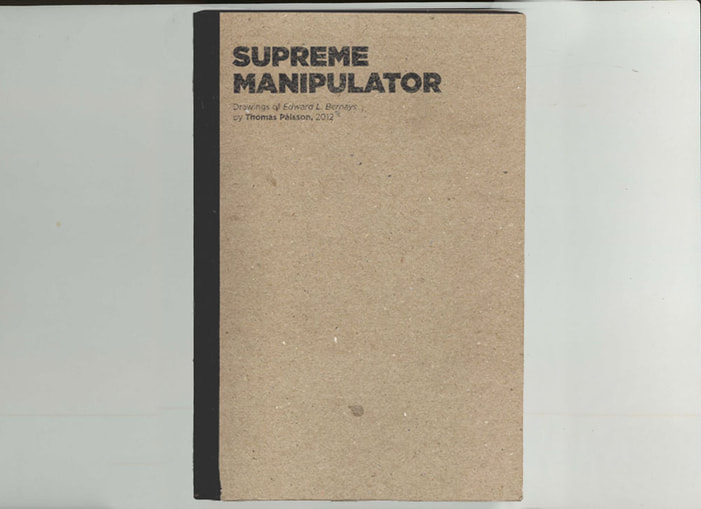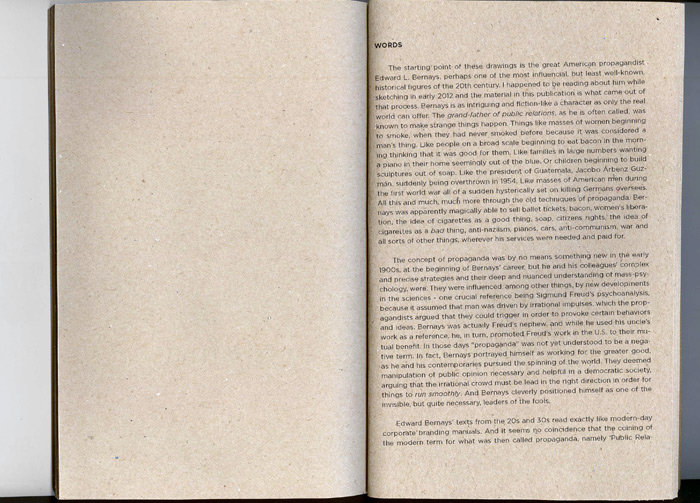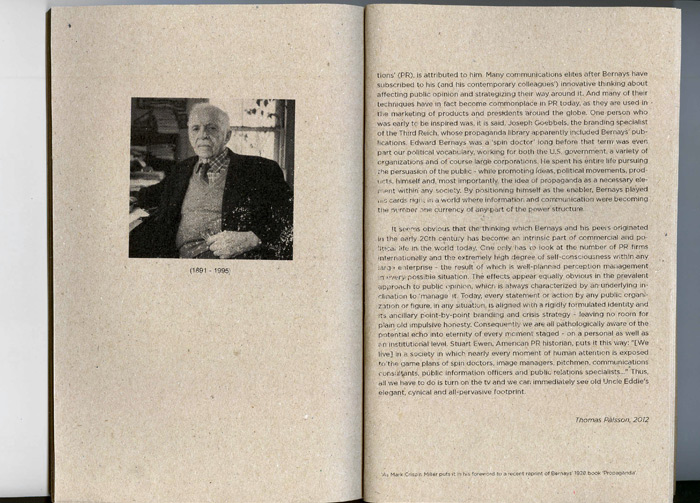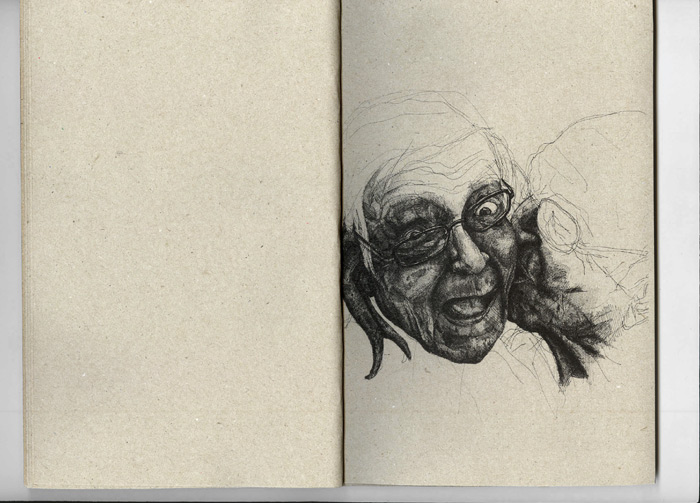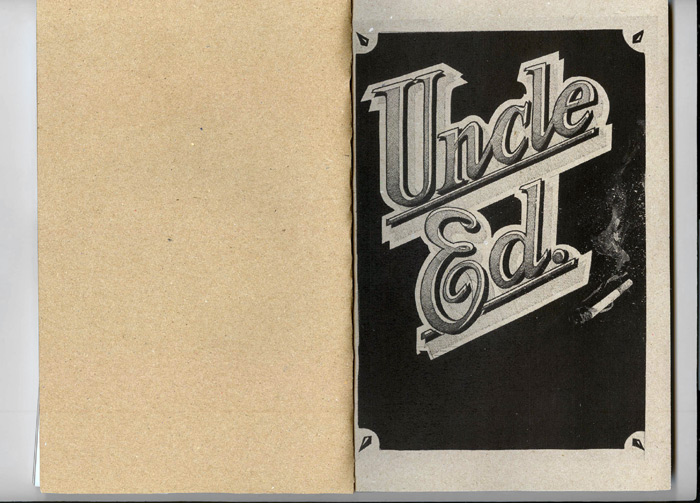SUPREME MANIPULATOR - Drawings of Edward L. Bernays
15x21 cm / Oplag: 50 stk.
Forlag: It's All Good, 2012
Håndlavet bog i 50 eksemplarer udgivet i forbindelse med udstillingen af samme navn. Bogen gengiver de udstillede tegninger og beskriver baggrunden for projektet - historien om den indflydelsesrige propagandaspecialist Edward L. Bernays og hans arv i nutiden.
Tekst fra bogen:
"The great American propagandist Edward L. Bernays is perhaps one of the most influencial, but least well-known, historical figures of the 20th century. I happened to be reading about him while sketching in early 2012 and this exhibition is what came out of that process. Bernays is as intriguing and fiction-like a character as only the real world can offer. The grand-father of public relations, as he is often called, was known to make strange things happen."
Se udstillingen her
15x21 cm / Oplag: 50 stk.
Forlag: It's All Good, 2012
Håndlavet bog i 50 eksemplarer udgivet i forbindelse med udstillingen af samme navn. Bogen gengiver de udstillede tegninger og beskriver baggrunden for projektet - historien om den indflydelsesrige propagandaspecialist Edward L. Bernays og hans arv i nutiden.
Tekst fra bogen:
"The great American propagandist Edward L. Bernays is perhaps one of the most influencial, but least well-known, historical figures of the 20th century. I happened to be reading about him while sketching in early 2012 and this exhibition is what came out of that process. Bernays is as intriguing and fiction-like a character as only the real world can offer. The grand-father of public relations, as he is often called, was known to make strange things happen."
Se udstillingen her
Tekst fra bogen:
"The great American propagandist Edward L. Bernays is perhaps one of the most influencial, but least well-known, historical figures of the 20th century. I happened to be reading about him while sketching in early 2012 and this exhibition is what came out of that process. Bernays is as intriguing and fiction-like a character as only the real world can offer. The grand-father of public relations, as he is often called, was known to make strange things happen. Things like masses of women beginning to smoke, when they had never smoked before because it was considered a man's thing. Like people on a broad scale beginning to eat bacon in the morning thinking that it was good for them. Like families in large numbers wanting a piano in their home seemingly out of the blue. Or children beginning to build sculptures out of soap. Like the president of Guatemala, Jacobo Árbenz Guzman, suddenly being overthrown in 1954. Like masses of American men during the first world war all of a sudden hysterically set on killing Germans oversees. All this and much, much more through the old techniques of propaganda. Bernays was apparently magically able to sell ballet tickets, bacon, women's liberation, the idea of cigarettes as a good thing, soap, citizens rights, the idea of cigarettes as a bad thing, anti-naziism, pianos, cars, anti-communism, war and all sorts of other things, wherever his services were needed and paid for.
"WE DON'T DEAL IN IMAGES... WE DEAL IN REALITY"
(Edward L. Bernays, 1999.)
The concept of propaganda was by no means something new in the early 1900s, at the beginning of Bernays' career, but he and his colleagues' complex and precise strategies and their deep and nuanced understanding of mass-psychology, were. They were influenced, among other things, by new developments in the sciences - one crucial reference being Sigmund Freud's psychoanalysis, because it assumed that man was driven by irrational impulses, which the propagandists argued that they could trigger in order to provoke certain behaviors and ideas. Bernays was actually Freud's nephew, and while he used his uncle's work as a reference, he, in turn, promoted Freud's work in the U.S. to their mutual benefit. In those days "propaganda" was not yet understood to be a negative term. In fact, Bernays portrayed himself as working for the greater good, as he and his contemporaries pursued the spinning of the world. They deemed manipulation of public opinion necessary and helpful in a democratic society, arguing that the irrational crowd must be lead in the right direction in order for things to run smoothly. And Bernays cleverly positioned himself as one of the invisible, but quite necessary, leaders of the fools.
"THE CONSCIOUS AND INTELLIGENT MANIPULATION OF THE ORGANIZED HABITS AND OPINIONS OF THE MASSES IS AN IMPORTANT ELEMENT IN DEMOCRATIC SOCIETY. WE ARE GOVERNED, OUR MINDS ARE MOLDED, OUR TASTES FORMED, OUR IDEAS SUGGESTED, LARGELY BY MEN WE HAVE NEVER HEARD OF. ... IT IS THEY WHO PULL THE WIRES WHICH CONTROL THE PUBLIC MIND."
(Edward Bernays, Propaganda 1928.)
Edward Bernays' texts from the 20s and 30s read exactly like modern-day corporate branding manuals. And it seems no coincidence that the coining of the modern term for what was then called propaganda, namely 'Public Relations' (PR), is attributed to him. Many communications elites after Bernays have subscribed to his (and his contemporary colleagues) innovative thinking about affecting public opinion and strategizing their way around it. And many of their techniques have in fact become commonplace in PR today, as they are used in the marketing of products and presidents around the globe. One person who was early to be inspired was, it is said, Joseph Goebbels, the branding specialist of the Third Reich, whose propaganda library apparently included Bernays' publications. Edward Bernays was a 'spin doctor' long before that term was even part our political vocabulary, working for both the U.S. government, a variety of organizations and of course large corporations. He spent his entire life pursuing the persuasion of the public - while promoting ideas, political movements, products, himself and, most importantly, the idea of propaganda as a necessary element within any society. By positioning himself as the enabler, Bernays played his cards right in a world where information and communication were becoming the number one currency of any part of the power structure.
It seems obvious that the thinking which Bernays and his peers originated in the early 20th century has become an intrinsic part of commercial and political life in the world today. One only has to look at the number of PR firms internationally and the extremely high degree of self-consciousness within any large enterprise - the result of which is well-planned perception management in every possible situation. The effects appear equally obvious in the prevalent approach to public opinion, which is always characterized by an underlying inclination to 'manage' it. Today, every statement or action by any public organization or figure, in any situation, is aligned with a rigidly formulated identity and its ancillary point-by-point branding and crisis strategy - leaving no room for plain old impulsive honesty. Consequently we are all pathologically aware of the potential echo into eternity of every moment staged - on a personal as well as an institutional level. Stuart Ewen, American PR historian, puts it this way:"[We live] in a society in which nearly every moment of human attention is exposed to the game plans of spin doctors, image managers, pitchmen, communications consultants, public information officers and public relations specialists..." Thus, all we have to do is turn on the tv and we can immediately see old Uncle Eddie's elegant, cynical and all-pervasive footprint.
Thomas Paalsson, 2012.

